
Male Pattern Baldness
Male pattern baldness, also known as androgenic alopecia, is the most common type of hair loss that occurs in men. According to the U.S. National Library of Medicine, more than 50 percent of men over the age of 50 may be affected by male pattern baldness.
Find out more about the symptoms, causes, factors, and treatment options for male pattern baldness.
What Is Male Pattern Baldness?
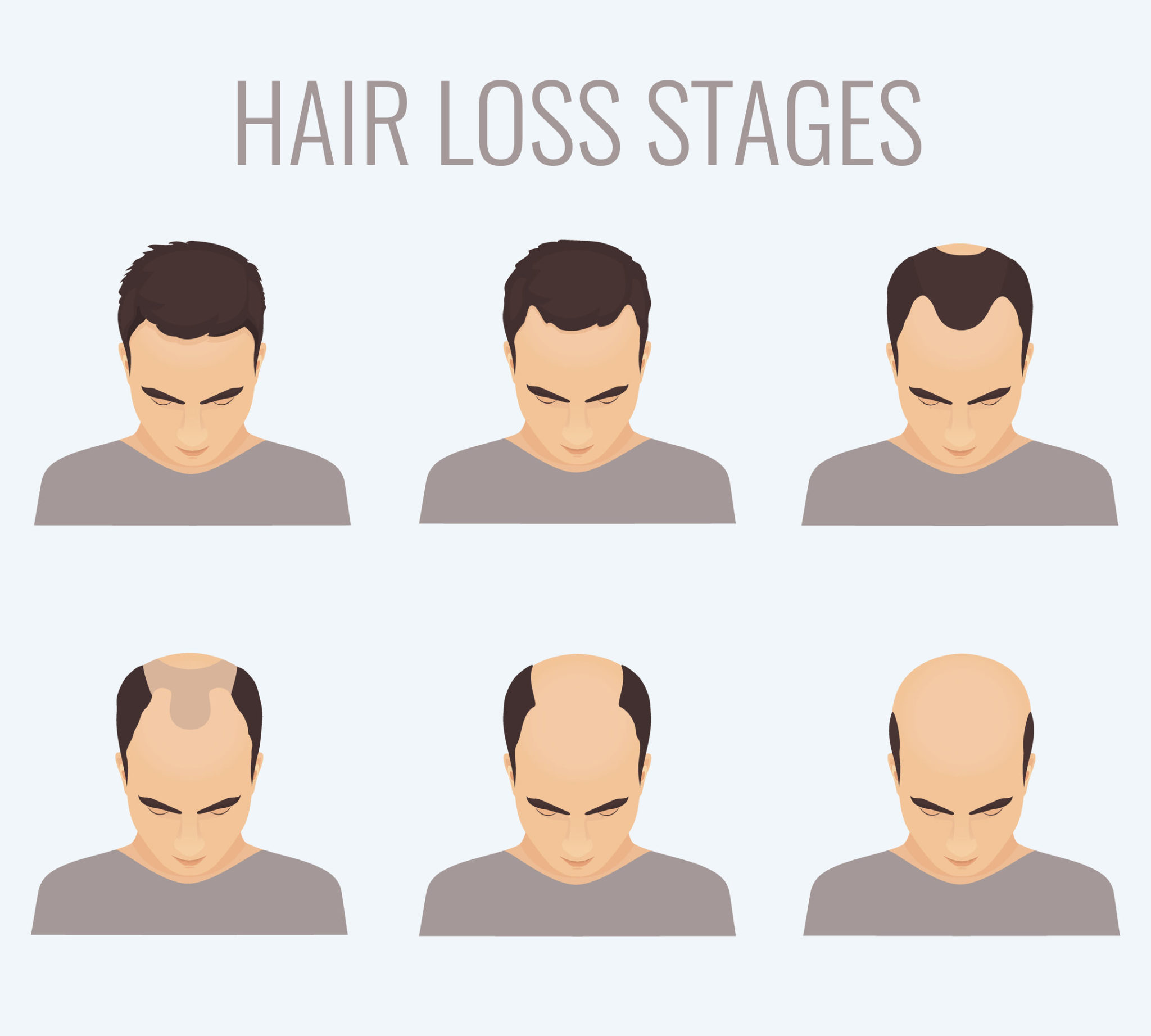
Male pattern baldness or hair loss is marked by the progressive thinning of hair on the head, eventually leading to baldness. For most men, the hair loss begins at the temples with a gradually receding hairline. The hair at the crown, or back, of the head may also begin to thin out.
This hair loss pattern is usually in an “M” pattern from the forehead. In severe cases, a bald patch over the crown will meet at the top points over time, forming a horseshoe shape. This leaves hair only around the back and sides of the head.
Hair Growth Cycle
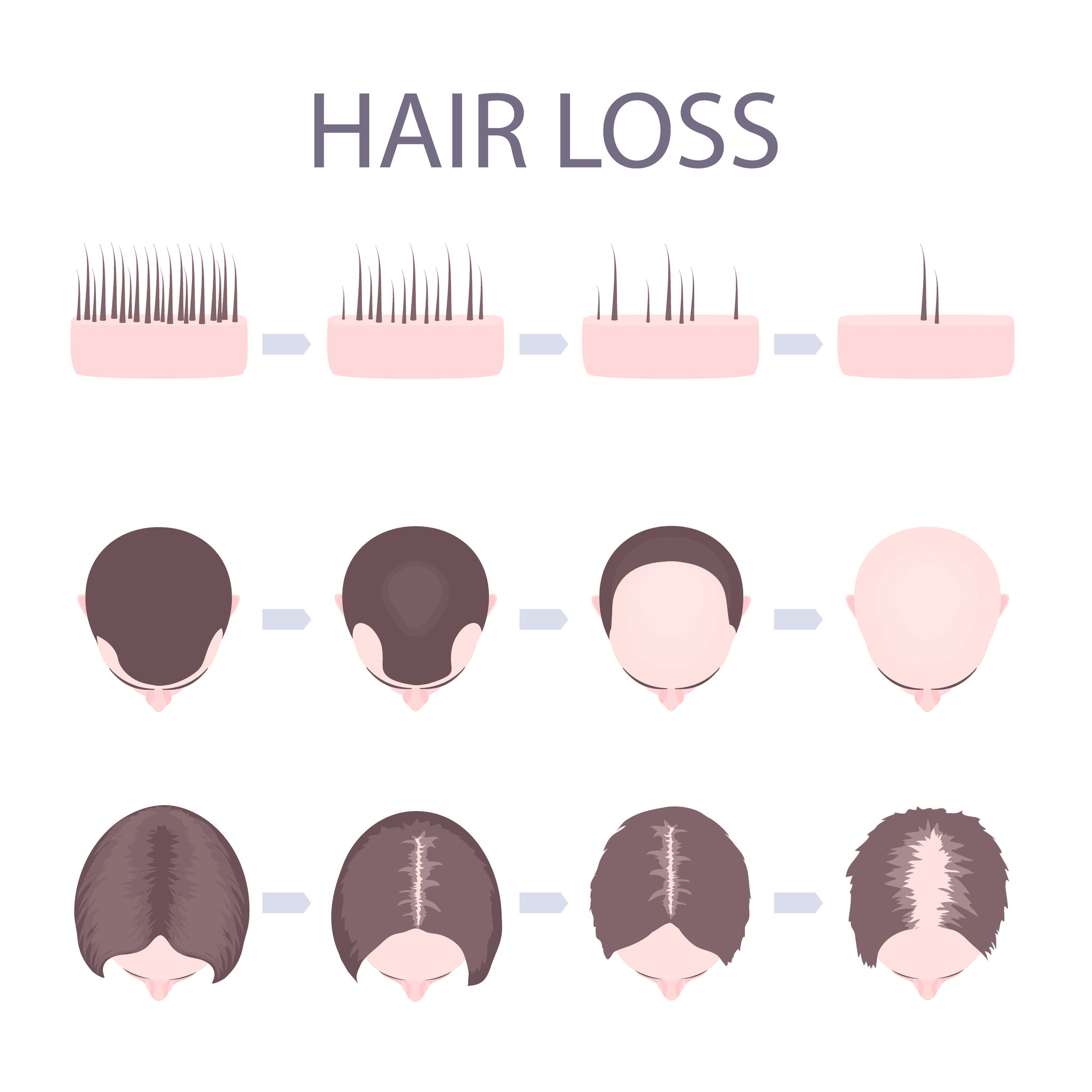
Understanding hair loss begins with understanding the process by which hair grows.
There are four phases to the hair growth cycle:
- Anagen: Anagen, or the growing phase, is the phase during which the hair grows. During this phase, the hair is continuously and actively growing, usually lasting three to five years. Some people can have an anagen phase up to seven years, however. Because hair continuously grows during the anagen phase, the length of this phase determines the maximum hair length. For most people, this length is 18 to 30 inches.
- Catagen: Catagen, or the regression phase, is the phase during which the hair follicles shrink and detach from the skin. After each follicle completes its anagen phase, it enters into the catagen phase, during which the hair follicle will shrink in size and then detach from the skin. Though the hair detaches at this point, it typically doesn’t fall out until much later in the cycle.
- Telogen: Telogen, or the resting phase, is the phase during which the new hair begins to grow under the older, detached hairs. Once the hair follicle enters the catagen phase and detaches from the scalp, it begins the telogen phase, which lasts for three to five months before the hair is forced out by new hair growth. Most people have 10 to 20 percent of their hair in a telogen phase at any given time, but certain medical conditions or high-stress situations can cause an increased number of follicles to enter the telogen phase, leading to shedding.
- Exogen: Exogen, or the shedding phase, is the phase during which the older hair falls out from the scalp and is replaced by new growth. Once the new hair has grown, the old hair enters the exogen phase, detaches from the scalp, and falls out, typically during grooming. For most people, it’s normal to have between 50 and 150 hairs enter this phase and fall out daily. As the new hair grows, it replaces the old hair and completes the cycle.
Each of these stages lasts for different lengths of time, so hair can grow for months or years before it enters into the catagen, telogen, and exogen phases.
Male Pattern Baldness
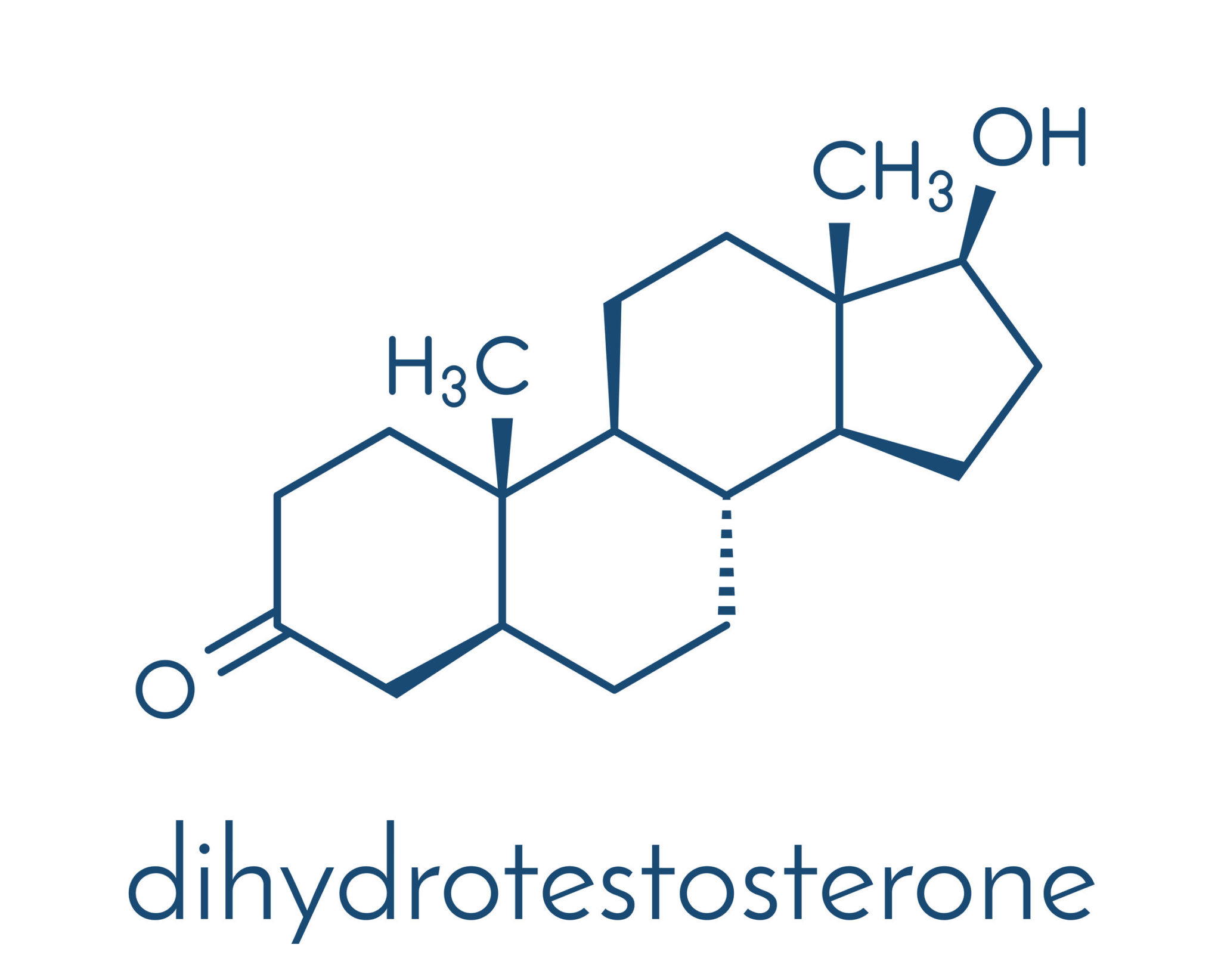
For men, testosterone is the most important androgen and is required for normal reproductive and sexual function. Testosterone accounts for the physical changes that occur during male puberty, such as the development of the penis and testes, and the development of secondary sexual characteristics, such as facial hair and body hair.
The body converts testosterone into dihydrotestosterone (DHT) by the enzyme 5-alpha reductase. DHT acts on different organs in the body, such as the cells in the prostate and the hair follicles. In men with male pattern baldness, the hair follicles are more sensitive to DHT, leading to hair follicle miniaturization (the hairs become thinner and shorter with each growth cycle) at a young age. Then, over the hair growth cycle, the shrunken hair follicle produces shorter and finer strands of hair. Eventually, the growth cycle for each hair ends and no new hair grows in to replace it.
In most cases, male pattern baldness is genetic, but certain health conditions may cause hair breakage, patchy hair loss, rash, redness, pain, peeling of the scalp, and other unusual symptoms that accompany hair loss. These are different from male pattern baldness.
Male Pattern Baldness Factors
Male pattern baldness can begin in the teenage years, but it most commonly occurs in adult men. The likelihood of male pattern baldness increases with age, especially in men with many close genetic relatives who exhibit male pattern baldness, particularly on the maternal side. It’s also been associated with other medical conditions, such as coronary heart disease and enlargement of the prostate. Disorders of insulin resistance, such as diabetes and obesity, prostate cancer, and hypertension have also been connected to male pattern baldness.
Hair Loss Myths
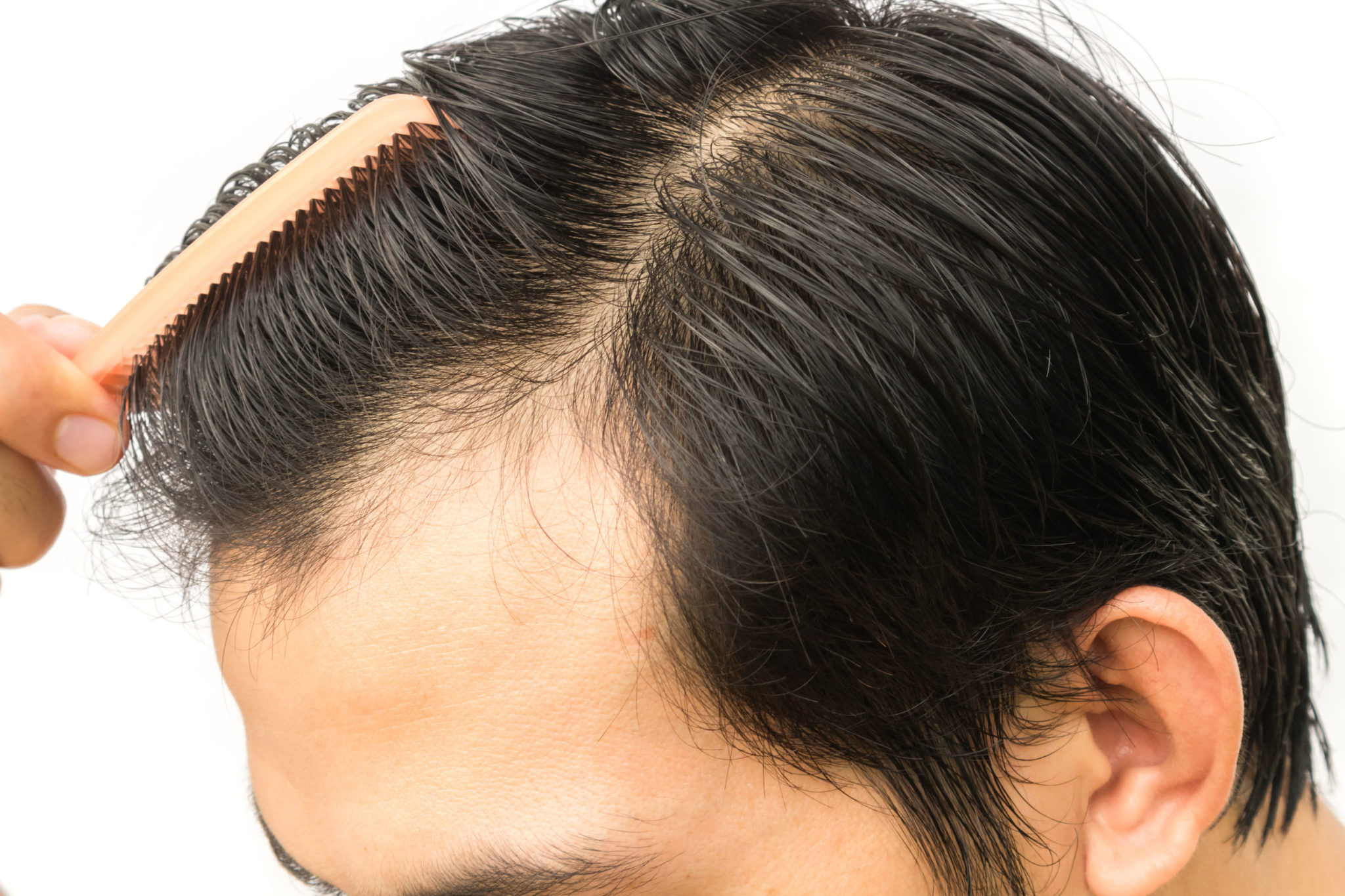
Despite the prevalence of male pattern baldness, many myths about its causes and treatments still exist.
Here are the most common hair loss myths:
- Shampoo makes you lose your hair: Shampooing doesn’t cause hair loss and it’s healthier for your hair and scalp to stay clean.
- You inherit hair loss from your mother:There is an old wives tale that a man will have his hair look that of his maternal grandfather.This is not true. Hair loss that occurs on your mother’s side doesn’t alone determine your hair loss. However, genetics are the most common factor in hair loss. You can inherit hair loss from either side of the family.
- Baldness is common after 50: Hair loss can occur at any age,even beginning in the late teenage years, though it’s more common and more severe as we age.
- Direct sunlight causes hair loss: While it’s important to protect your scalp from the damage of UV radiation, direct sunlight won’t make your hair fall out.
- Hats cause hair loss: The myth that hair loss is caused by wearing hats too often has been around for a while. There is no evidence that wearing a hat damages your scalp or hair follicles.
- Male pattern baldness is caused by increased testosterone levels: While testosterone does play a role in hair loss from its conversion to DHT, it has no direct effect on your hair follicles or hair loss.
- Hair products cause hair loss: Hair styling products, such as gels, hair spray, or hair mousse, can cause buildup on your hair and scalp irritation, but not hair loss.
- Stress causes male pattern baldness: While extreme stress can cause temporary hair loss, it’s not a contributing factor in male pattern baldness, which is a permanent medical condition.
Treatments for Hair Loss
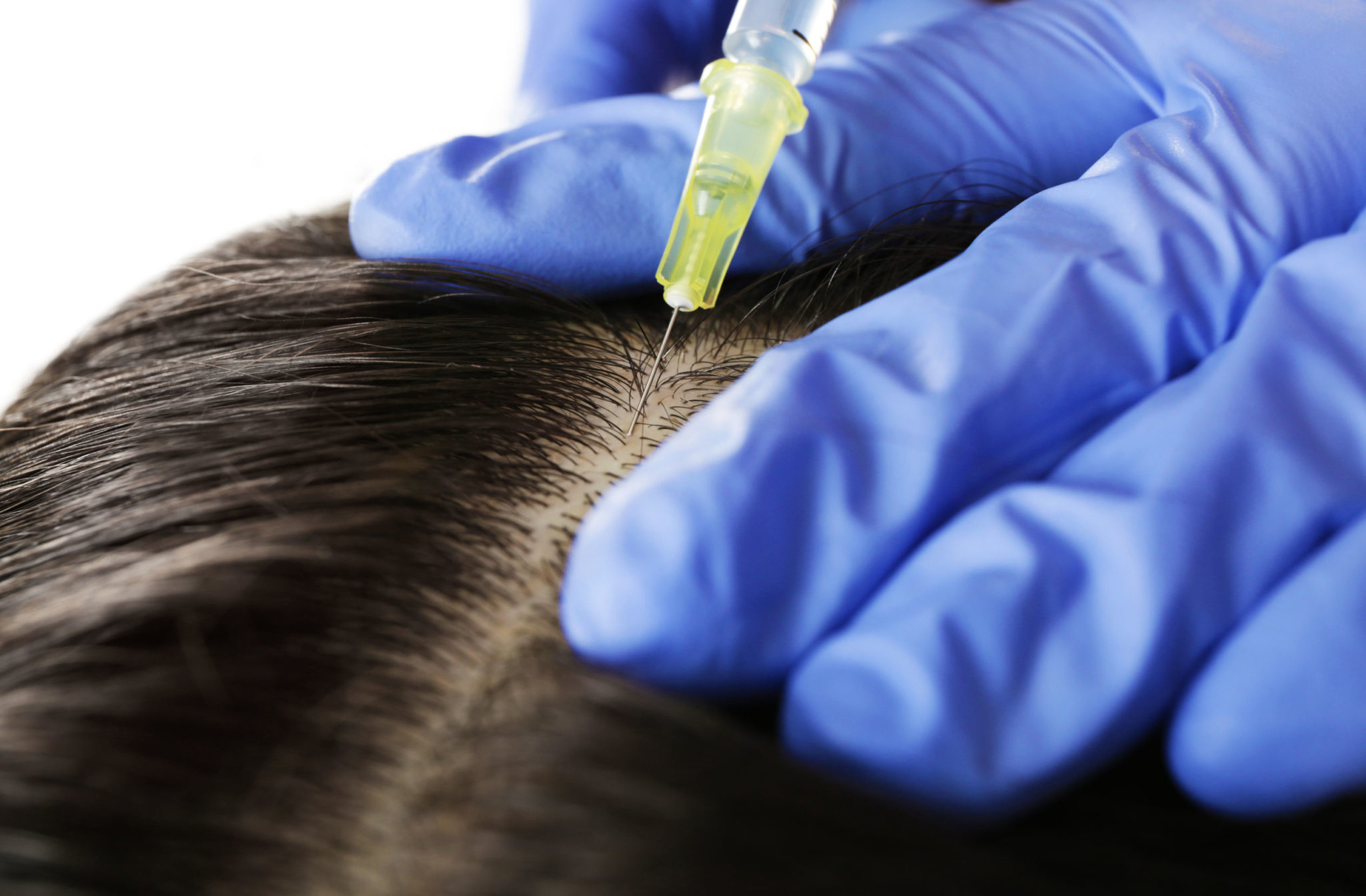
Unless hair loss occurs secondary to a health problem or medication, medical treatment isn’t necessary for hair loss. However, male pattern baldness is a cosmetic issue for many men, and there are several treatment options.
Hairstyles
In the early stages or with minimal hair loss, men can sometimes hide hair loss with the right haircut or hairstyle.
Wigs and hairpieces are also an option to hide thinning hair, receding hairline, or complete baldness. Wigs come in a variety of colors, textures, and styles, so it’s easy to find one to match your natural hair.
Weaves, or wigs that are sewn into your natural hair, are also an option, but you must have enough hair to sew the weave into. Weaves aren’t as likely to fall off as a hairpiece or wig, so they’re suitable for sleeping or physical activities, but they must be repeatedly sewn into new hair growth and may damage your natural hair.
Medications
A few medications are available to treat and prevent hair loss, such as:
Minoxidil
Minoxidil, also known as Rogaine, is a topical medication that’s applied to the scalp to slow hair loss and stimulate the hair follicles to grow hair. Rogaine takes between four months and a year to produce visible results, and the hair loss usually recurs once the medication stops.
Side effects of Rogaine include scalp dryness, burning, irritation, and scaling. More serious side effects include weight gain, swelling of the hands, feet, abdomen, or face, shortness of breath, chest pain, and rapid heartbeat, all of which require medical attention.
Finasteride
Finasteride, also known as Propecia or Proscar, is an oral medication that works to slow hair loss by blocking the conversion of testosterone to DHT. Finasteride has a higher success rate than Rogaine, but like Rogaine, hair loss returns once you stop taking it.
Finasteride will produce hair growth between three months and a year, but if no hair growth occurs after that time, it’s best to stop taking it.
Side effects of Finasteride include:
- Depression.
- Itching.
- Rash.
- Hives.
- Breast growth or tenderness.
- Facial swelling.
- Painful ejaculation.
- Testicle pain.
- Impotence.
In rare cases, finasteride can also cause breast cancer. It may also impact the prostate-specific antigen tests used for prostate cancer screenings, since it lowers the natural levels. Because of this, any rise in prostate-specific antigen levels should be evaluated by a doctor.
Hair Transplant
Hair transplant is a permanent, surgical treatment for male pattern baldness. This procedure uses existing hair to implant onto the bald spots on the head, which is harvested by follicular sample or graft from areas of the head with thick hair.
There are two types of hair transplant treatments: Follicular Unit Transplantation (FUT) and Follicular Unit Extraction (FUE).
FUT,often called a strip harvest technique, requires a large section of the skin on the scalp is harvested and extracted, then turned into smaller grafts. The bald patches on the head serve as the transplant recipient sites, which are created with local anesthetic and small needles. This procedure is typically indicated for patients with large bald areas.
With FUE, small, individual follicle grafts are taken from thicker areas of the scalp and transplanted into the bald areas. In the past this procedure was sometimes reserved for patients with small areas of balding and thinning. In more recent years various formats for FUE have become the primary procedure for a large percentage of patients, thus avoiding the large visible scar left by the FUT or strip harvest method
With either procedure, once the grafts are harvested, the transplant locations are cleaned and anesthetized to prepare for transplantation. A needle or scalpel is used to create small incisions in the transplant site and the grafts are transferred. This process can take several hours.
After the procedure, the transplanted hair stubble will fall out, leaving healthy follicles behind. This allows new hair growth to appear from the transplanted follicles, typically within six to nine months after surgery. The early signs of growth occur around four to five months after surgery.
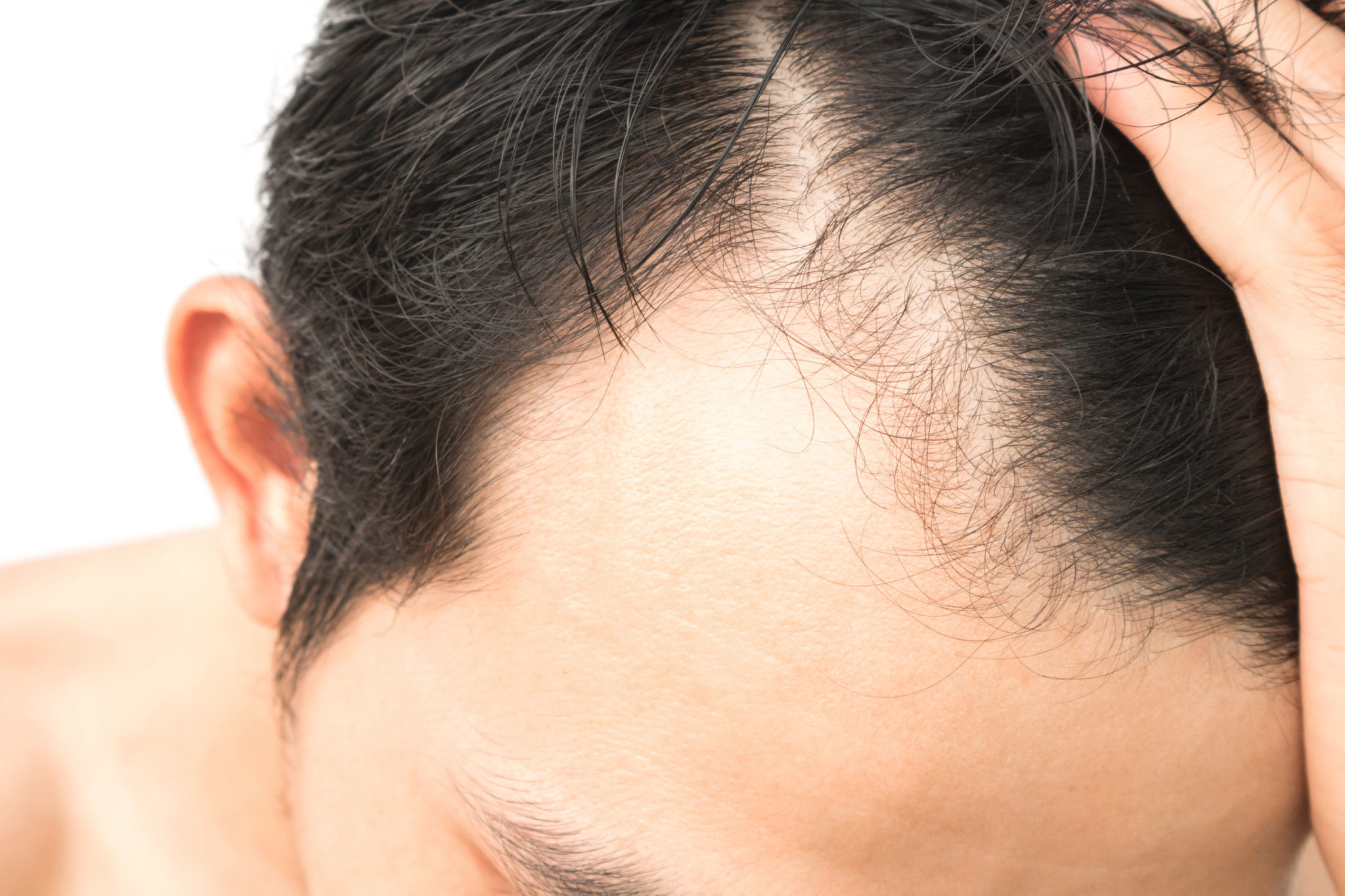
For most patients, the only recovery and side effects are a tender scalp that’s manageable with simple pain medications or anti-inflammatory drugs. Patients may also be prescribed an antibiotic to minimize the risk of infection and bandages to the graft areas. Most patients are able to return to work a few days after the surgery.
Hair transplant is a surgical procedure. It offers a permanent solution for hair loss. It is only recommended for patients with severe and permanent hair loss. Patients with medical conditions, such as diabetes or heart disease, perpetual hair loss, scalp disorders, psychological conditions that cause damage to the hair, are not good candidates for hair transplant.
Hair transplant surgery has few side effects, with the most common being swelling of the scalp or face in the days following surgery or mild pain or discomfort. Some patients experience a mild infection of the hair follicles, called folliculitis. Antibiotics and compresses are sufficient to relieve the problem.
Severe side effects, such as infection or bleeding, are rare. There’s also a risk of scarring or unnatural-looking new hair growth, as well as a sudden loss of the original hair in the area of transplantation, also known as shock loss. This is quite rare and not usually permanent, however.
One of the major advantages of hair transplant surgery for male pattern baldness is that the grafted follicles come from the areas of the scalp that aren’t affected by male pattern baldness, so the new growth areas are more likely to grow into full, thick hair–permanently.
Though hair transplant surgery is safe and generally has favorable results, it’s important to remember that it’s still a surgical procedure. Before undergoing hair transplant surgery, be sure to research your hair transplant surgeon and ensure they have adequate experience and credentials for your safety.
Hair transplant is a cosmetic procedure. Attractive, natural results require a surgeon with experience and skill to maximize the density, coverage, and realistic look of the transplant, especially with the hairline. Be sure to choose a surgeon you feel comfortable with and make sure to be truthful in disclosing all information about your medical history, family history, and goals for treatment. You should ask any questions and address concerns during your initial consultation.
Visit Vegas Valley Hair Restoration

Male pattern baldness can be devastating for many men, especially with so few solutions to prevent or treat it. Fortunately, hair transplant surgery offers a permanent solution for the specific challenges of male pattern baldness, giving you the possibility of a full, healthy head of hair.
If you think hair transplant surgery is right for you, it’s important to select a qualified hair transplant surgeon to increase the likelihood of good results. Everything from the patterns of hair growth to the shape and quality of the hairline can affect the final results, so you’ll want to choose a surgeon with the experience and skill necessary to achieve natural-looking results, such as Dr. Simon at Vegas Valley Hair Restoration.
In Southern Nevada we provide the revolutionary NeoGraft Hair Restoration procedure, a minimally invasive, FDA-approved hair treatment that’s free from sutures, scars, or strip harvest incisions, so you can enjoy a full head of living, growing hair with minimal risks. Dr. Simon is also a board-certified surgeon with years of experience providing patients with male pattern baldness and other types of hair loss with attractive results using these hair transplant procedures.
Contact us today to set up your free consultation and discuss your hair transplant options!